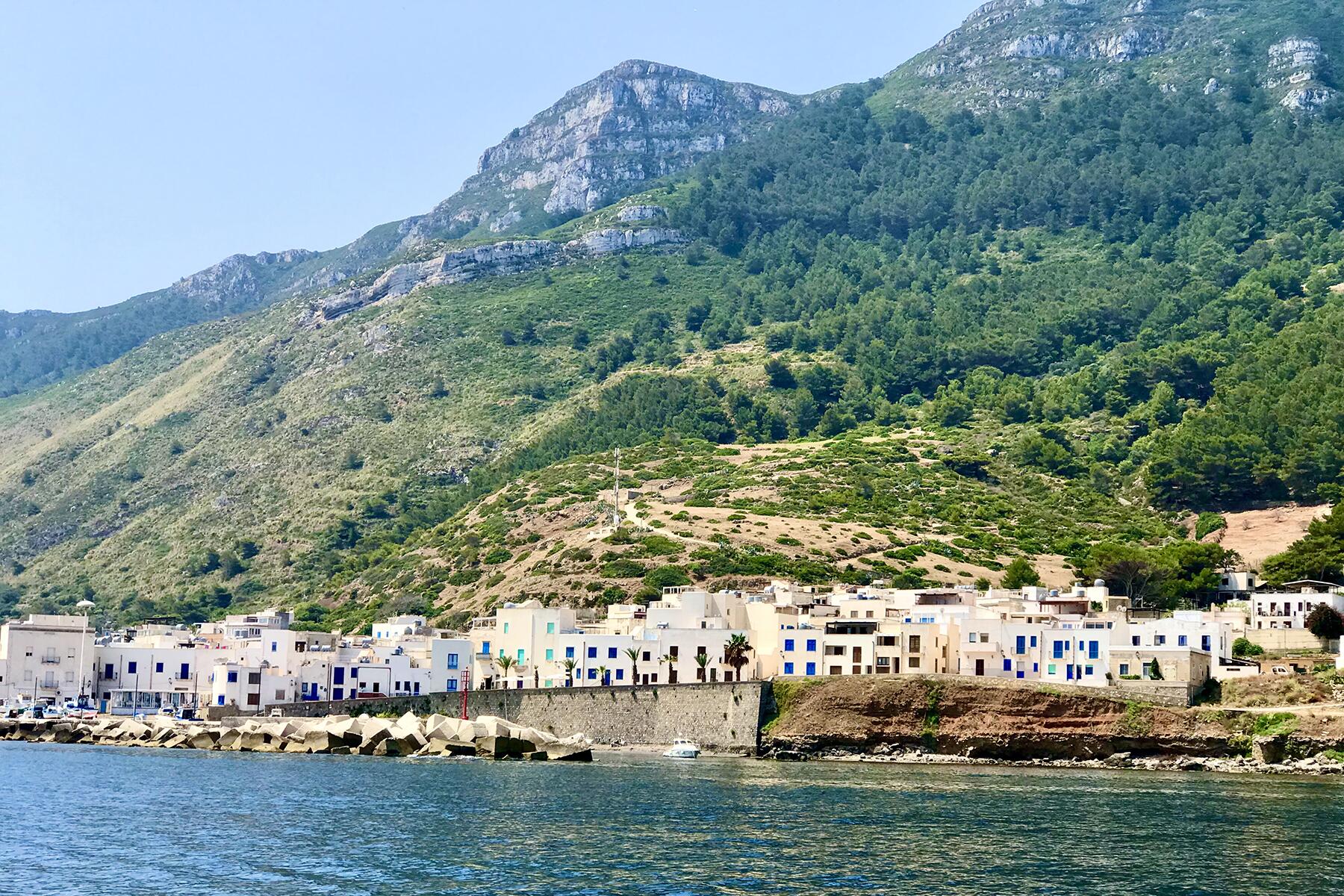“Sing to me of the man, Muse, the man of twists and turns…driven time and again off course, once he had plundered the hallowed heights of Troy.”
I’ve always been fascinated by The Odyssey and the awesome voyage of Odysseus, all the magical spots he visited, and the strange creatures he bumped into while sailing from burning Troy back home to his weeping lonely wife. He’s the first savvy globetrotter of mankind. Figuring out where exactly in the Mediterranean his magical wanderings took place may seem like a head-splitting riddle. But in time scholars and geographers, helped by Homer’s tips, have located a few spots in Italy. So I set off along Odysseus’ trail relying also on amazing “alternative readings” of the epic poem. Here’s where I landed: most are remote, unknown atolls you’ve never heard of.
Ponza
Kinky, chic, exotic. It’s the jewel of the Pontine archipelago off Rome’s coast, dubbed the Romans’ Bahamas. This is said to be where Odysseus was bewitched by the beautiful sorceress Circe—after she turned his men into pigs. Homer called the witch’s isle by its ancient Greek name—Eea.
Palms, wildflowers, and prickly pears give it a tropical vibe. Shaped like a crescent moon it’s a labyrinth of colorful sea grottos, white pebble beaches with translucent waters, granite rocks with weird patterns, and tall reddish-yellow cliffs that look like corners of Mars. Boutiques and cocktail bars, such as La Maga Circe, are named after the two lovers.
I get lost in the maze of winding cobbled alleys and steps connecting bright yellow, purple, red, green, and blue fishermen dwellings covered in pink bougainvilleas. The harbor is lined with ancient Roman fisheries and cisterns where I dive in to refresh. Many villagers live in elegantly restyled prehistoric grottos. Ponza is also where Roman consuls came to skinny-dip and work on their tan. Locals say Odysseus’ boat docked at the Parata inlet’s sea stacks jutting out of fluorescent blue waves where I kayak in zig-zags and go snorkeling. Odysseus and Circe’s lovemaking was so passionate that, according to myth, they had three sons, one of whom went searching for his father and ended up marrying his step-mom Penelope. But that’s another story.
Ventotene
A short ferry boat trip from Ponza takes me to the nearby tiny one square mile former prison island of Ventotene, whose name in the local dialect gives a nod to the strong winds blowing here. Part of a pristine marine reserve turned into a diving Mecca with friendly barracudas and giant groupers, this is where Odysseus was harassed by more weird and scary women—the sirens. Poor guy, to resist the tempting song of these half-bird, half-women creatures who had the power to drive men insane and make them drown he ordered his companions to tie him to the mast and plug their ears. Odysseus was the only one who listened to the sirens’ enchanting song, bringer of such deep knowledge and secrets that no man could bear it except him, the hero. Yup, despite what you may think, in Greek mythology the sirens weren’t sexy ladies with sensual fishtails and shell bras. They were ugly harpies with lethal, high-pitched voices. Homer says they lived on a flat, barren isle topped with skeletons. Ventotene is as flat as a pancake and shaped like a lizard, with a low bushy countryside where farmers grow lentils.
Nobody knows the forbidden contents of the sirens’ chant but in the evening, as I sip a fennel digestive, I can hear them singing to each other, and it’s not a pleasant melody. Ventotene is bird-watching heaven where there’s a weird ugly bird called “berta” that shrieks like a baby. Locals dub it the “sirens’ scream.” The place is mesmerizing. Humble, simple, and wild, prepare for a no-frills, laid-back stay in former prison cells overlooking black-pebble beaches and mushroom-shaped sea stacks. The few locals suntan on black volcanic rocks down at the lighthouse. My buttocks are blue-bruised at the end of the day but it’s the best spot to admire the sunset and the distant view of the Vesuvius. The isle is tiny yet packed with so many things to see: the majestic Bourbon fortress, the mosaic-covered ruins of an ancient Roman villa, and prison undergrounds. Bars and boutiques are inside grottos lining the minuscule port where fishermen sell their catch.
Recommended Fodor’s Video
Scilla and Cariddi
You know when you’re stuck between a rock and a hard place? It’s not just a figure of speech. Italians say “between Scilla and Cariddi”—and that’s a real place. It’s in the Strait of Messina, right between the picturesque town of Scilla on the tip of Calabria and Peloro Cape on the opposite Sicilian coast. Here Odysseus’ ship was attacked by two sea monsters who embodied the fears of ancient sailors when navigating this deadly narrow strip of sea. The heroic crew was caught between Scylla, an octopus-like man-eating demon with dog-headed tentacles, and the beast Charybdis that constantly sucked in water and spat out water. Scylla was the personification of dangerous pointed sea rocks and Charybdis of gigantic whirlpools and violent currents that swallowed boats. Still, nowadays it is a treacherous, deep spot where the seabed is dotted with ancient wrecks and sunken statues. But the towns are charming. Scilla’s pastel-colored fishermen huts are nestled at the feet of cliff-hanging fortresses where the monster was said to live while Peloro Cape, with the tiny ancient hamlet of Torre Faro, boasts one of Sicily’s most stunning, round-shaped sandy beaches.
Marettimo
Quaint, offbeat, secluded, with pristine shores and translucent waters. It’s the wildest and farthest island of Sicily’s Egadi archipelago, where silence rules. Pinkish granite cliffs, Byzantine chapels, solitary pebble-stone inlets, and purple-pink animal-shaped grottos home to monk seals dot the coast. A few islanders move around on donkeys and you might bump into deers and wild boars in the bushes. There’s just one sleepy village frozen in time with dazzling white and blue fishermen dwellings that harbors a secret. According to an alternative reading of The Odyssey by 19th-century English author Samuel Butler, this is the real, legendary home of Odysseus—not the island of Ithaca in Greece. Which, today, would make him an Italian. Marettimo’s ancient Greek name is Hiera, meaning “sacred.” Forget social buzz, crowded beaches, and hotels. It’s one of Italy’s most under-the-radar destinations great for detox, unplugged stays. One single road connects the village to a spooky, crumbly overhanging pirate fortress.
In his literary work, The Authoress of the Odyssey, Butler also claims Homer is a con man, for the epic poem was actually written by a Sicilian poetess-princess called Nausicaa. After re-reading the masterpiece in ancient Greek, Butler set off on a long journey across Sicily and landed in Marettimo in search of confirmation to his theory. Strolling along the harbor past the tiny bars selling delicious cannoli and cassatelle pastries, there’s a little dwelling with a panoramic window overlooking the shimmering blue sea. That’s the cottage where Butler sojourned, an epigraph on the white-washed wall pays homage to his memory. The wooden bench nearby, where Butler sat admiring the view, has peeling-off paint due to the salty air. Locals are proud to boast such an élite past visitor.
Levanzo
Marettimo’s sister-isle Egadi chain, is the pearl of the archipelago, the tiniest and cutest island, Levanzo. Islanders exploit Butler’s version and claim this is where The Odyssey’s one-eyed Cyclops Polyphemus lived inside a huge cave which can be visited by boat and is covered in beautiful graffiti of early men that tell a spellbinding tale on the origins of the universe. Blinded by Odysseus, the giant tried stopping the fleeing hero by throwing huge rocks at his ship which fell into the sea and turned into a ragged sea stack shaped like the back of a dinosaur called Faraglione. Sunbathers attempt to swim to the stack from the beach but are trapped amid nasty currents and shallows that form a pleasant natural jacuzzi pool. I almost drowned in the endeavor, so I settled for a leg water massage up to my hip.
The isle, a former hippie retreat, is a nudist heaven. Locals suntan naked behind rocks while tourists happily swim topless. The dazzling white fisherman village overlooks aquamarine-colored water, and the harbor is lined with bouncy boats and dinghies. A lush pinewood forest hides a secluded inlet that used to be the ancient port. There are ghostly old military barracks and a few abandoned dwellings with unhinged doors and broken windows. Villagers have turned lookout towers into panoramic studios. You can walk to all inlets but forget soft sandy beaches. Feet will hurt and I tore three pairs of flip flops jumping from rock to rock and walking on pebbles. But I’m glad I did.




